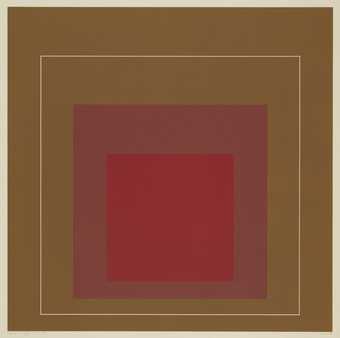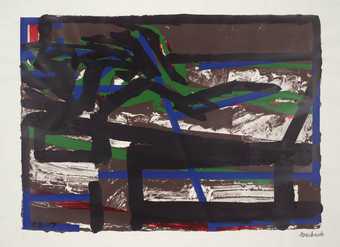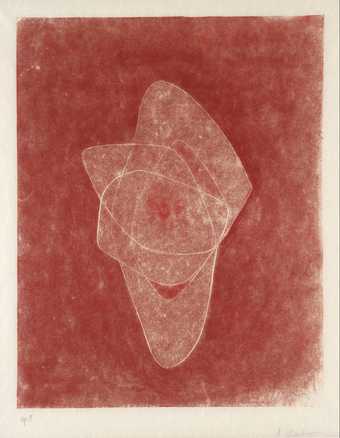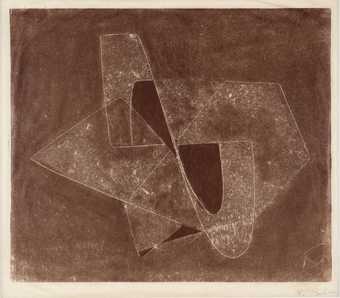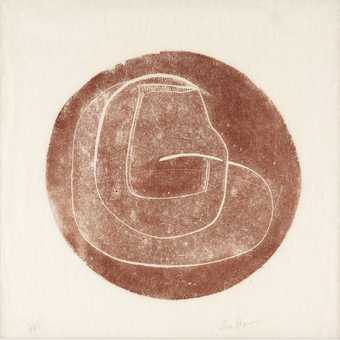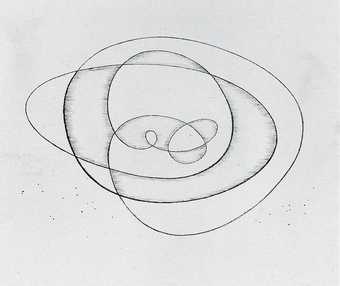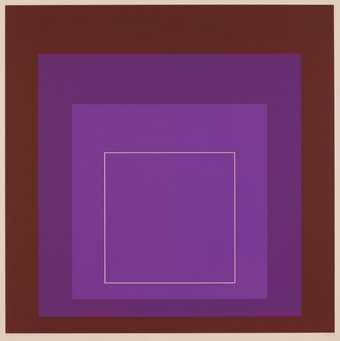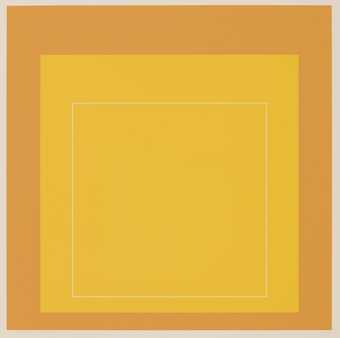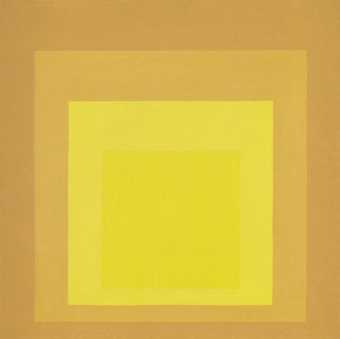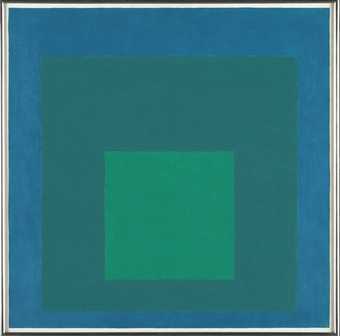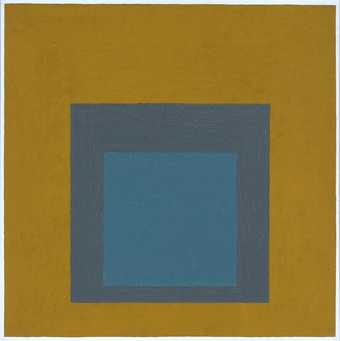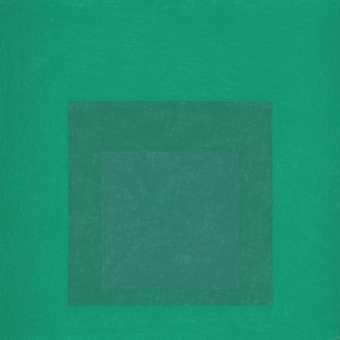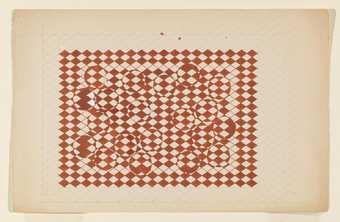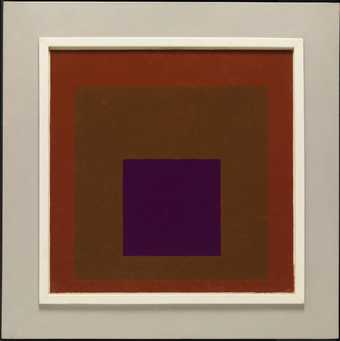
Not on display
- Artist
- Anni Albers 1899–1994
- Medium
- Screenprint on paper
- Dimensions
- Support: 420 × 470 mm
- Collection
- Tate
- Acquisition
- Presented by the American Fund for the Tate Gallery, courtesy of Melinda Shearer Maddock 2017
- Reference
- P14776
Summary
TR III is a square printed and embossed work on paper. It consists of a gold-printed surface into which small, wide-based triangles have been embossed in a tight motif of thirty-six neat rows. Some of the triangles point upwards while others point downwards, and further triangles of similar sizes are created by the unembossed negative spaces between them. Shimmering highlights are formed where the light catches the edges of the printed shapes and where it travels across the smooth gold surface of the composition’s thick border. Pencil inscriptions at the lower left and right give the title, the edition (number 38 of a total of 60), the artist’s name and the year of production. The lower left also bears two further embossed marks: a copyright symbol and the glyph of the zodiac sign of Gemini, which is the motif used by the print workshop Gemini G.E.L. (Graphic Editions Limited).
Anni Albers designed and produced TR III in 1969–70 in Los Angeles with the assistance of Gemini G.E.L. The work was created using a two-stage process. Firstly, gold coloured ink was screenprinted over the entire sheet of Waterleaf paper, and evidence of the texture of the mesh of the screen can be seen in the surface of the print, accentuating the shimmering effect of the gold. Secondly, after the ink had dried, the sheet was embossed using a matching pair of zinc dies or stamps.
The precise meaning of the letters ‘TR’ in the title is unknown, but is likely to be an abbreviation of the word ‘Triadic’ (meaning a group of three) which was used for some of Albers’s earlier prints. Her arrangement of triangles in TR III is identical, yet laterally inverted, in her earlier works in the same series: TR I 1968–70 and TR II 1969–70 (both Museum of Modern Art, New York). For these prints Albers also worked with Gemini G.E.L. and produced aluminium plates in three inks – red, orange and pale orange for TR I and green, grey and pale grey for TR II.
Albers made many trips to Mexico and South America during her career and TR III shows the impact on her practice of Mexican and Peruvian textiles, with their repeated use of identical triangular features. The influence of Albers’s own earlier textile works is also apparent in TR III. The aggregation of triangles raised on the gold field of the embossed print is redolent of the warp and weft of threads of woven fabric. The writer Nicholas Fox Weber has described the visual connections between Albers’s work in different media as follows: ‘Anni’s world, her materials, her wall hangings and upholstery fabrics and jewellery and drawings of meandering lines and prints of patterns locked into a grid, all juxtapose what is very solid and sure and steady with what is adventurous, uncertain, mysterious.’ (Nicholas Fox Weber, ‘Anni Albers’, in Anni Albers: Design Pioneer, exhibition catalogue, Ruthin Craft Centre, Ruthin 2010, p.13.) As Albers acknowledged in 1982, ‘What I had learned in handling threads, I now used in the printing process. Again I was led. My prints are not transfers from paintings to color on paper as is the usual way. I worked with the production process itself.’ (Albers 1982, accessed 1 October 2016.)
Further reading
Anni Albers, ‘Material as Metaphor’, delivered as part of the panel discussion ‘The Art/Craft Connection: Grass Roots or Glass Houses?’, College Art Association’s 70th Annual Meeting, New York, 25 February 1982, extract available at http://www.albersfoundation.org/teaching/anni-albers/lectures/#tab5, accessed 1 October 2016.
Virginia Gardner Troy, ‘Thread as Text: The Woven Work of Anni Albers’, in Anni Albers, exhibition catalogue, Solomon R. Guggenheim Museum, New York 1999, pp.28–39.
Nicholas Fox Weber and Brenda Danilowitz, The Prints of Anni Albers: A Catalogue Raisonné, 1963–1984, Mexico City 2009, reproduced p.77.
Pete Gubbins
December 2016
Supported by the Terra Foundation for American Art.
Does this text contain inaccurate information or language that you feel we should improve or change? We would like to hear from you.
Explore
- abstraction(8,615)
-
- non-representational(6,161)
-
- geometric(3,072)
- countries and continents(17,390)
- lifestyle and culture(10,247)
-
- design(24)
You might like
-
Josef Albers White Line Square IV
1966 -
Frank Auerbach Reclining Figure II
1966 -
Naum Gabo Opus 8
c.1969 -
Naum Gabo Opus 10
c.1969 -
Naum Gabo Opus 11
1965–8 -
Josef Albers Beta
1939 -
Josef Albers White Line Square III
1966 -
Josef Albers White Line Square XI
1966 -
Josef Albers White Line Square XV
1966 -
Josef Albers Study for Homage to the Square: Departing in Yellow
1964 -
Josef Albers Study for Homage to the Square: Beaming
1963 -
Josef Albers Study for Homage to the Square
1963 -
Josef Albers Study for Homage to the Square
1964 -
Josef Albers Untitled Abstraction V
c.1945 -
Josef Albers Homage to the Square: Study for Nocturne
1951

